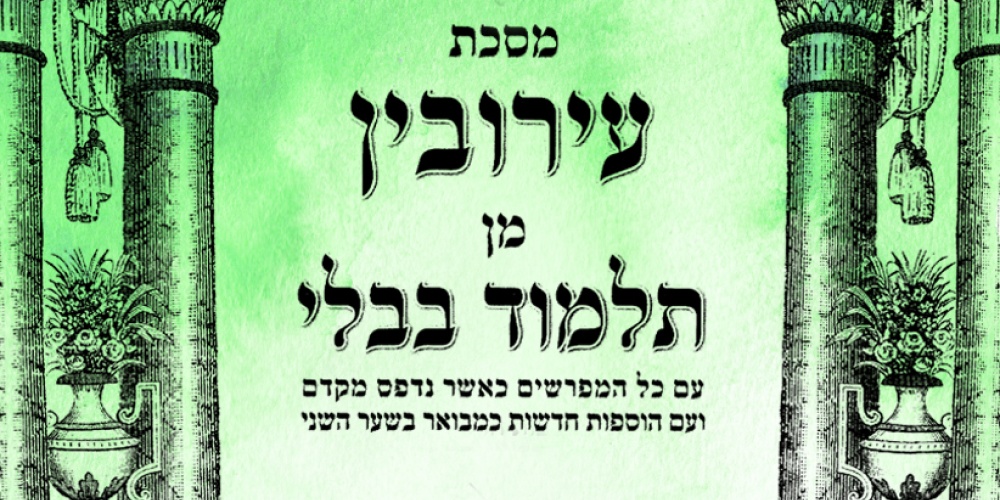
The focus of masechet Shabbat is the definition of the parameters of the 39 prohibited melachot, creative activities prohibited on Shabbat. Of the 39 melachot, it is that of carrying that, by a large margin, takes up more Talmudic discussion than any other. There may even be more discussion on this melacha than the other 38 melachot combined. The other 38 melachot are also creative activities that must cease on Shabbat, thereby acknowledging G-d as the ultimate Creator. But creating something with no means to bring it to market renders it almost meaningless. Society advances only when new products are available for others to use. Therefore, it is the carrying or transportation of these goods that gives meaning to the other 38 melachot[1].
According to Torah law, one may not carry between a public and private domain, nor four cubits (the approximate space between two socially distanced people) in a public domain. The delineation between private and public property is not always easy to define; it must take into account such factors as size, shape, number of people, fences, and the like. Often, there is no clear border between these two types of domains. Hence, in order to prevent one from inadvertently carrying from one domain to the other, our Sages “created” a new domain—that of a carmalit, for semi-private and semi-public areas—declaring it forbidden to carry from or into a carmalit from either a public or private domain.
At the same time, the rabbis made way for an exemption, allowing one to carry into or from a carmalit if certain necessary safeguards were taken. These safeguards, what we call an eiruv, consist of two distinct parts. There must be some kind of a physical marker, delineating the area as private or, perhaps more accurately, not public. In addition, each person residing in the “enclosed” area must contribute some food to be held in one of the homes of the area, symbolically uniting them as one social unit. As with one large family who live in the same enclosed space bringing food for a “pot-luck” meal, the complete living area can be treated as a private one, allowing one to carry from house to house. With these precautions in place we can revert to Biblical law, allowing one to carry in and around all types of private domains. It is this same system we use today, albeit on a much grander scale, to build our modern-day eiruvin[2].
It is these laws that are the subject of the first Mishna in masechet Eiruvin.
In Talmudic times, it was common for a few homes to share a common courtyard, a chatzer. Adjacent courtyards would share a common alleyway, a mavui, that would lead to a public thoroughfare. According to the Torah law, the chatzer and the mavui are private domains where carrying is permitted. Yet out of fear that one may accidentally carry from the mavui to the street, a public thoroughfare, the Sages forbade carrying both within the chatzer and the mavui.
However, if the mavui is clearly delineated as a distinct “private” area, one would be allowed to carry within the courtyards and alleyway, as there would be little fear that one might accidentally carry from the mavui to the street[3].
This delineation can be done in one of two ways. One can either put a korah, a beam, across the top of the entrance way to the alley, or one can place a lechi, a post, along the side of one of the entrance ways to the alley.
The opening Mishna of the masechet quotes a dispute between the Sages and Rabbi Yehuda as to the maximum height of this beam. The Sages, concerned that it would not be noticed if it was too high, insisted that the korah must be within 20 amot (approximately 30 feet) of the ground[4]. Rav Yehuda disagrees, allowing a much higher beam.
In analyzing this debate, the Gemara quotes the explanation of Rav, who suggested that the debate revolves around the architecture of the Temple. The Sages note that the entryway to the heichal—the area of the Temple that housed the menorah, the Shulchan and the golden altar[5]—stood at 20 amot. Rav Yehuda, on the other hand, argued that since the entrance way to the ulam, the antechamber, was 40 amot, the mavui can be at least that high.
The derivation of the laws regarding a residential courtyard from the Temple architecture is somewhat unusual. While the actual 39 prohibited melachot on Shabbat are derived from the Mishkan, the definition of the melacha has little to do with how it was carried out in the Mishkan. Rather, we look to how this activity is normally done in society at large. One violates Shabbat if one carries enough wood to cook an egg, enough spices to season that egg, or enough dye to colour a small garment; the prohibition of cooking is violated if food is one-third cooked, as that is the point at which food is somewhat edible. In defining what type of knot is prohibited to tie we look to camel drivers and sailors, not to what was tied in the Temple.
The workings of the Mishkan may be the source of the melachot, yet the 39 melachot were “violated” each and every Shabbat in the Temple. With the melachot to be kept only outside the Temple, it stands to reason that the definition of these melachot would be determined by how they are done outside the Temple. Why then do we derive the laws of entryways from the Temple, as opposed to looking to the construction industry for guidelines?
This is another example of how our home is a miniature Temple. We wash before we eat, put salt on the bread, and hide the knives for birchat hamazon to mimic what happened in the Temple. As we enter an alleyway to make our way to a courtyard and then the homes of our fellow Jews, we are reminded that a Jewish neighbourhood is a “holy” place, with the sanctity, at least symbolically, of the Temple. It is the Jewish home, not the synagogue or even the Temple, that is the centre of Jewish life. A home is not just a place to live; it is the place where we welcome the divine presence, creating an atmosphere of holiness in all that we do.
Rav Yehuda and the Sages debate as to whether our home is like the antechamber leading us to the inner sanctum, or more akin to the heichal itself, the inner chamber (only the kodesh kedoshim, entered on Yom Kippur, had greater sanctity). Both the ulam and the heichal were places to which only kohanim were allowed entry. If one wants to carry from one home to another, we must ensure that our homes reflect our status as “a mamlechet kohanim, a kingdom of priests, and a holy nation”.
[1] Thus, despite the closed border between Canada and the United States, an exception is made for the transport of goods and materials. If those too were to be unable to cross, much more of economic life would totally collapse, putting millions at near-term risk.
[2] I imagine few of you have actually contributed food to help make the eiruv, something that should render the “eiruv” useless. However, based on the principle that one legally acquires a gift from the moment the gift-giver delivers the gift to a messenger, what happens today is that food is donated on your behalf—even without your knowledge—to participate in the eiruv. You might to think of it as someone making a donation to charity in your name.
[3] Modern-day eiruvin are built under the assumption that all the streets in a city are akin to a mavui, allowing us to build eiruvin even in large cities. Only a highway or a major thoroughfare with some 600,000 travellers a day is today considered to be a public domain. How the street has gone from a public domain in Talmudic times to a private domain today is well beyond the scope of this particular devar Torah. Suffice it to say that eiruvin is one of the most specialized and complex areas of Jewish law.
[4] For similar reasons, a sukkah must not be more than 20 amot high, nor may Chanukah candles be lit more than 20 amot from the ground. While Rav Yehuda disagrees regarding the sukkah, he does not dissent regarding Chanukah. With the mitzvah of Chanukah specifically labelled as pirsumei nissa, publicizing the miracle, noticing it is crucial. Regarding sukkah, this aspect is only of a secondary nature, the primary emphasis being on the nature of the sukkah. The Sages require a sukkah to be a temporary structure, and anything over 20 amot is deemed permanent, whereas Rav Yehuda argues that a permanent structure is perfectly fine—hence, there is no restriction necessary on height.
[5] This was used daily for the incense offering and for the special service on Yom Kippur. All other sacrifices were offered on the outer altar, an area that was open to non-kohanim.



